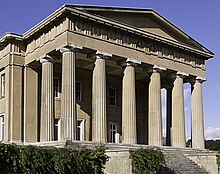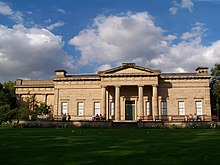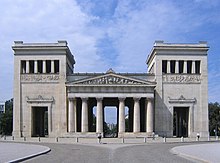
Back إحياء إغريقي Arabic Yunan oyanışı memarlığı Azerbaijani Greek Revival German Ελληνική αναβίωση (αρχιτεκτονική) Greek Neogriego (arquitectura) Spanish معماری احیای یونانی Persian Greek revival Finnish Greek Revival French התחייה היוונית (אדריכלות) HE Architettura neogreca Italian



Greek Revival architecture was a style that began in the middle of the 18th century but which particularly flourished in the late 18th and early 19th centuries, predominantly in northern Europe, the United States, and Canada, and Greece following that nation's independence in 1821. It revived many aspects of the forms and styles of ancient Greek architecture, including the Greek temple. A product of Hellenism, Greek Revival architecture is looked upon as the last phase in the development of Neoclassical architecture, which was drawn from Roman architecture. The term was first used by Charles Robert Cockerell in a lecture he gave as an architecture professor at the Royal Academy of Arts in London in 1842.[1]
With newfound access to Greece and Turkey, or initially to the books produced by the few who had visited the sites, archaeologist–architects of the period studied the Doric and Ionic orders. Despite its universality rooted in ancient Greece, the Greek Revival idiom was considered an expression of local nationalism and civic virtue in each country that adopted it, and freedom from the lax detail and frivolity that then characterized the architecture of France and Italy, two countries where the style never really took architecturally. Greek Revival architecture was embraced in Great Britain, Germany, and the United States, where the idiom was regarded as being free from ecclesiastical and aristocratic associations and was appealed to each country's emerging embrace of classical liberalism.


The taste for all things Greek in furniture and interior design, sometimes called Neo-Grec, reached its peak in the beginning of the 19th century when the designs of Thomas Hope influenced a number of decorative styles known variously as Neoclassical, Empire, Russian Empire, and Regency architecture in Great Britain. Greek Revival architecture took a different course in a number of countries, lasting until the 1860s and the American Civil War and later in Scotland.

Modern-day architects are recreating this design by building houses similar to the Greek Revival.[where?] These houses are characterized by their symmetrical and balanced proportions, typically featuring a bold, pedimented portico with arched openings. The symmetrical façade is divided into two equal halves.